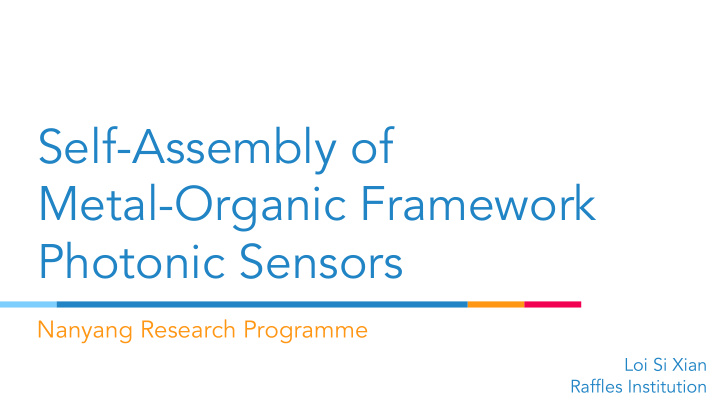



Self-Assembly of Metal-Organic Framework Photonic Sensors Nanyang Research Programme Loi Si Xian Raffles Institution
INTRODUCTION
Photonic Crystals
Photonic Crystals Photonic crystals consist of periodic arrangements of ● regularly shaped materials with different dielectric constants These crystals exhibit a photonic band gap, where ● electromagnetic propagation is completely prohibited in the specified frequency band, giving the crystals a structural colour.
Photonic Crystals Isotropic spherical colloids have conventionally been used to ● create ordered photonic superstructures, but anisotropic particles offer more packing geometries and functions. Unlike ordered superstructures, amorphous photonic ● structures (APSs) with short range order and randomly packed scatters, do not require homogeneous shapes and particle sizes, and are easier to fabricate.
Objective To create amorphous photonic sensors through the use of ● zeolitic imidazolate framework-8 (ZIF-8) metal-organic framework (MOF) particles HYPOTHESIS: The APS will be able to demonstrate optical ● properties comparable to ordered superstructures and should show potential for vapour sensing applications
MOF Particles Metal-organic framework (MOF) particles are hybrid, ● crystalline materials that have a dynamic porous framework ZIF-8, an MOF particle, has high crystallinity, a large surface ● area and good chemical and thermal stability Structure of ZIF-8 (Lee, 2015)
METHODS
Synthesis of MOF Particles Colloidal rhombic dodecahedral (RD) ZIF-8 Particles: 2-methylimidazole (MiM), polyvinylpyrrolidone (PVP), and ● varying amounts of sodium acetate were dissolved in methanol Methanol solution with Zn(NO 3 ) 2 ·6H 2 O was subsequently ● added, and the reaction mixture was incubated overnight Particles were purified by repeated centrifugation and ● washing with ethanol.
Synthesis of MOF Particles Cubical ZIF-8 Particles: Cetyltrimethylammonium bromide (CTAB) ● was used to modulate the growth rates of the ZIF-8 particles CTAB selectively attaches to the {100} ● facets of the nanocrystals to facilitate the Schematic of the facets of ZIF-8 (Avci, 2017) synthesis of cubical ZIF-8 particles.
Infiltration Driven Colloidal Assembly of MOF Photonic Structures Rapid infiltration of a 15μL drop of colloidal solution ● transports particles to be fixed on photo paper Illustration of three different infiltration methods (a) Infiltration driven colloidal assembly (b) Infiltration driven coating (c) Radial infiltration driven colloidal assembly
MOF APSs for Vapour Sensing Vapour was run through a gas chamber where the sensor ● was placed in. Overview of experimental process
RESULTS
Characterisation of MOF Particles B A Average particle height: 111.03nm Average particle height: 178.07nm C D Average particle height: 232.92nm Average particle height: 268.56nm SEM images of cubical (A-D) ZIF-8 particles with varying sizes
Characterisation of MOF Particles A B Average particle height: 199.35nm Average particle height: 219.62nm Average particle height: 414.37nm Average particle height: 264.70nm SEM images of cubical (E-H) RD ZIF-8 particles with varying sizes
Optical Properties of MOF Photonic Structures Patterned MOF APSs with different structural colours were ● obtained, with clear peaks in optical reflectance spectrum Rod coating MOF APSs by RD particles with (a) different colours and (b) corresponding reflectance
Optical Properties of MOF Photonic Structures Linear relationship observed between the particle height and maximum ● reflection wavelength (λ max ) for RD particles assembled through infiltration driven colloidal assembly ● Peaks in reflectance spectrum indicate photonic band gap functionality (a) λ max observed in the optical reflectance spectrum and (b) λ max plotted against particle height for RD ZIF-8 particles
MOF APSs for Gas Sensing (a) Optical images and (b) reflection spectra of the activated MOF APSs (infiltration driven coating) exposed to N 2 and saturated ETOH vapour Obvious colour change from green to yellow upon exposure to ethanol (ETOH) ● vapour (Figure 8a), and a red-shift in reflection peak from 550nm to 577nm (Figure 8b), due to change in refractive index ● Such sensors have higher sensitivity and shorter response times Clear change in colour allows for colorimetric vapour sensing ●
CONCLUSION AND FUTURE WORK
Conclusion and Future Work Morphology and optical properties of ZIF-8 particles can be ● controlled RD ZIF-8 particles can be used to create MOF APSs for ● colorimetric vapour sensing Further extensions include to develop MOF APSs with ● distinct kinds of MOF materials with improved sensitivity to different vapours and vapour concentrations Develop and construct of MOF vapour sensing arrays ●
Acknowledgements “ I would like to extend my sincere gratitude to my research mentor, Dr Bai Ling, the Nanyang Research Programme, the School of Chemical and Biomedical Engineering, Nanyang Technological University, my school, Raffles Institution, and my school coordinator, Dr Lena Lui, for their guidance and support throughout this research journey.
Thank you!
Recommend
More recommend